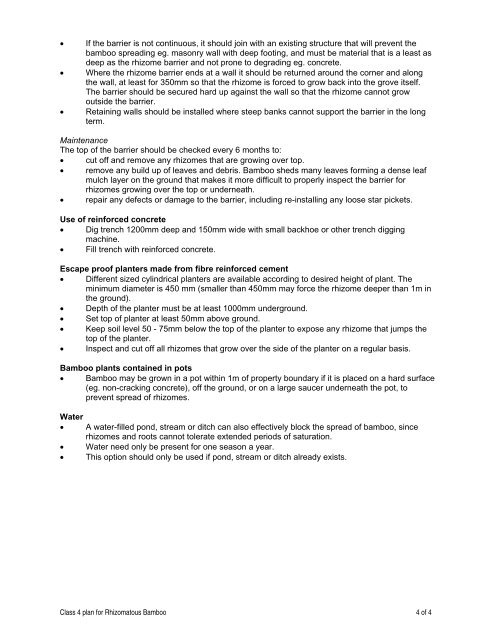ordinary meeting of council to be held on tuesday, 18 july 2006
ordinary meeting of council to be held on tuesday, 18 july 2006
ordinary meeting of council to be held on tuesday, 18 july 2006
You also want an ePaper? Increase the reach of your titles
YUMPU automatically turns print PDFs into web optimized ePapers that Google loves.
• If the barrier is not c<strong>on</strong>tinuous, it should join with an existing structure that will prevent the<br />
bamboo spreading eg. mas<strong>on</strong>ry wall with deep footing, and must <str<strong>on</strong>g>be</str<strong>on</strong>g> material that is a least as<br />
deep as the rhizome barrier and not pr<strong>on</strong>e <str<strong>on</strong>g>to</str<strong>on</strong>g> degrading eg. c<strong>on</strong>crete.<br />
• Where the rhizome barrier ends at a wall it should <str<strong>on</strong>g>be</str<strong>on</strong>g> returned around the corner and al<strong>on</strong>g<br />
the wall, at least for 350mm so that the rhizome is forced <str<strong>on</strong>g>to</str<strong>on</strong>g> grow back in<str<strong>on</strong>g>to</str<strong>on</strong>g> the grove itself.<br />
The barrier should <str<strong>on</strong>g>be</str<strong>on</strong>g> secured hard up against the wall so that the rhizome cannot grow<br />
outside the barrier.<br />
• Retaining walls should <str<strong>on</strong>g>be</str<strong>on</strong>g> installed where steep banks cannot support the barrier in the l<strong>on</strong>g<br />
term.<br />
Maintenance<br />
The <str<strong>on</strong>g>to</str<strong>on</strong>g>p <str<strong>on</strong>g>of</str<strong>on</strong>g> the barrier should <str<strong>on</strong>g>be</str<strong>on</strong>g> checked every 6 m<strong>on</strong>ths <str<strong>on</strong>g>to</str<strong>on</strong>g>:<br />
• cut <str<strong>on</strong>g>of</str<strong>on</strong>g>f and remove any rhizomes that are growing over <str<strong>on</strong>g>to</str<strong>on</strong>g>p.<br />
• remove any build up <str<strong>on</strong>g>of</str<strong>on</strong>g> leaves and debris. Bamboo sheds many leaves forming a dense leaf<br />
mulch layer <strong>on</strong> the ground that makes it more difficult <str<strong>on</strong>g>to</str<strong>on</strong>g> properly inspect the barrier for<br />
rhizomes growing over the <str<strong>on</strong>g>to</str<strong>on</strong>g>p or underneath.<br />
• repair any defects or damage <str<strong>on</strong>g>to</str<strong>on</strong>g> the barrier, including re-installing any loose star pickets.<br />
Use <str<strong>on</strong>g>of</str<strong>on</strong>g> reinforced c<strong>on</strong>crete<br />
• Dig trench 1200mm deep and 150mm wide with small backhoe or other trench digging<br />
machine.<br />
• Fill trench with reinforced c<strong>on</strong>crete.<br />
Escape pro<str<strong>on</strong>g>of</str<strong>on</strong>g> planters made from fibre reinforced cement<br />
• Different sized cylindrical planters are available according <str<strong>on</strong>g>to</str<strong>on</strong>g> desired height <str<strong>on</strong>g>of</str<strong>on</strong>g> plant. The<br />
minimum diameter is 450 mm (smaller than 450mm may force the rhizome deeper than 1m in<br />
the ground).<br />
• Depth <str<strong>on</strong>g>of</str<strong>on</strong>g> the planter must <str<strong>on</strong>g>be</str<strong>on</strong>g> at least 1000mm underground.<br />
• Set <str<strong>on</strong>g>to</str<strong>on</strong>g>p <str<strong>on</strong>g>of</str<strong>on</strong>g> planter at least 50mm above ground.<br />
• Keep soil level 50 - 75mm <str<strong>on</strong>g>be</str<strong>on</strong>g>low the <str<strong>on</strong>g>to</str<strong>on</strong>g>p <str<strong>on</strong>g>of</str<strong>on</strong>g> the planter <str<strong>on</strong>g>to</str<strong>on</strong>g> expose any rhizome that jumps the<br />
<str<strong>on</strong>g>to</str<strong>on</strong>g>p <str<strong>on</strong>g>of</str<strong>on</strong>g> the planter.<br />
• Inspect and cut <str<strong>on</strong>g>of</str<strong>on</strong>g>f all rhizomes that grow over the side <str<strong>on</strong>g>of</str<strong>on</strong>g> the planter <strong>on</strong> a regular basis.<br />
Bamboo plants c<strong>on</strong>tained in pots<br />
• Bamboo may <str<strong>on</strong>g>be</str<strong>on</strong>g> grown in a pot within 1m <str<strong>on</strong>g>of</str<strong>on</strong>g> property boundary if it is placed <strong>on</strong> a hard surface<br />
(eg. n<strong>on</strong>-cracking c<strong>on</strong>crete), <str<strong>on</strong>g>of</str<strong>on</strong>g>f the ground, or <strong>on</strong> a large saucer underneath the pot, <str<strong>on</strong>g>to</str<strong>on</strong>g><br />
prevent spread <str<strong>on</strong>g>of</str<strong>on</strong>g> rhizomes.<br />
Water<br />
• A water-filled p<strong>on</strong>d, stream or ditch can also effectively block the spread <str<strong>on</strong>g>of</str<strong>on</strong>g> bamboo, since<br />
rhizomes and roots cannot <str<strong>on</strong>g>to</str<strong>on</strong>g>lerate extended periods <str<strong>on</strong>g>of</str<strong>on</strong>g> saturati<strong>on</strong>.<br />
• Water need <strong>on</strong>ly <str<strong>on</strong>g>be</str<strong>on</strong>g> present for <strong>on</strong>e seas<strong>on</strong> a year.<br />
• This opti<strong>on</strong> should <strong>on</strong>ly <str<strong>on</strong>g>be</str<strong>on</strong>g> used if p<strong>on</strong>d, stream or ditch already exists.<br />
Class 4 plan for Rhizoma<str<strong>on</strong>g>to</str<strong>on</strong>g>us Bamboo 4 <str<strong>on</strong>g>of</str<strong>on</strong>g> 4
















